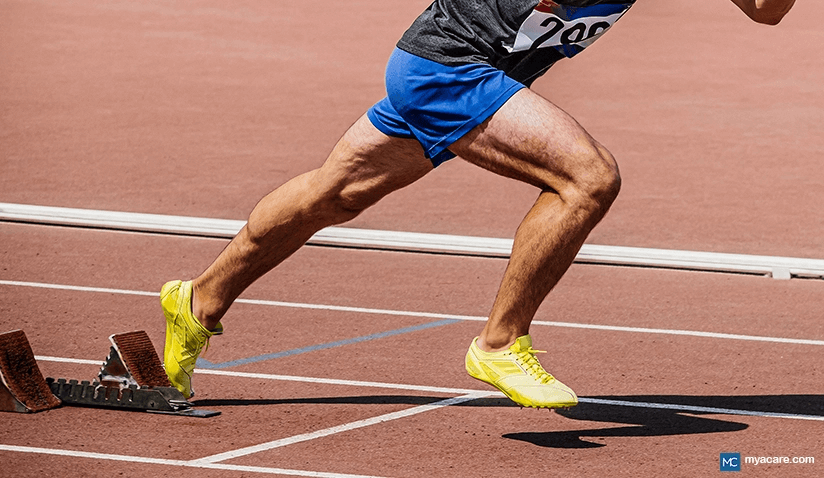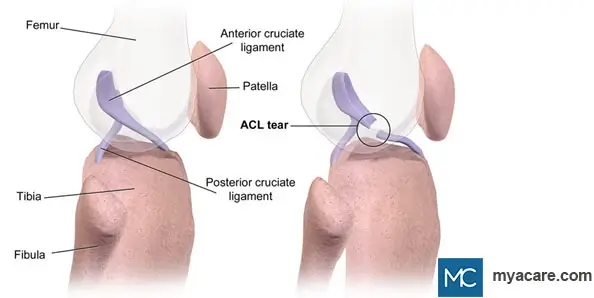Anterior Cruciate Ligament (ACL) Injury: Symptoms, Causes, Treatment

Anterior Cruciate Ligament (ACL) injury is one of the most common knee injuries reported. The ACL is a tough ligament that holds your knee joint together and provides it with stability.
Most ACL injuries happen in athletes, especially those participating in risky sports like football, basketball, and soccer. If you’re a sports fan, you’re likely already familiar with how serious an ACL injury or tear is.
The treatment method is usually decided case-by-case. It can be either conservative, with medications, rest, and physical therapy, or surgical.
Keep reading to learn more about the Anterior Cruciate Ligament, its injury, symptoms, risk factors, diagnosis, and treatment.
Anatomy
In order to understand what an ACL injury is, you first need to know a little about the anatomy of the knee and the anterior cruciate ligament. Your knee joint is made of 3 adjacent bones:
- The patella (kneecap)
- The femur (thigh bone)
- The tibia (shin bone)
These adjacent bones come together to form your knee. They are held tight together by several tough ligaments, tendons, and muscles. The anterior cruciate ligament (ACL) is an important ligament that runs inside your knee joint (see image), between the joint surfaces of your femur and tibia. The role of the ACL ligament is to provide stability to your knee by:
- Preventing the forward sliding of your shin bone
- Preventing abnormal rotation of your knee

Causes
Tear or sprain of the anterior cruciate ligament is very common in contact sports. It’s one of the most frequent (and most debilitating) knee injuries reported. You can think of the ACL as a tough cord of tissue connecting the shinbone and the thigh bone. Injury of the ACL can happen due to direct trauma or inappropriate knee motion which overstretches the cruciate ligament, leading to sprains and tears.
The following are the mechanisms that cause ACL injury:
- Inappropriate landing from a high fall/jump
- Switching running direction suddenly
- Sudden halt when running
- Forcefully reducing speed when running
- Direct trauma or collision to the knee
Symptoms
An ACL injury is usually a sports injury and is less likely to be seen in other settings. One very common sensation reported by patients is a “popping” sensation in their knees. This is a result of the sudden rupture of the tense and hard cruciate ligament.
If you’re doing sports or any other physical activity and you’ve hurt your knee, you might have an ACL injury if you have one or more of these symptoms:
- Intense and sudden “pop” feeling in the knee
- Rapid knee swelling within 24 hours of your injury
- Knee is painful to touch
- Inability to resume physical activity
- Pain or discomfort when walking
- Inability to fully move your knee in all normal directions
The rapid swelling and popping sound are usually specific symptoms of an ACL injury. If you’ve experienced these and you suspect that you might have an ACL tear, you should book an appointment with an orthopedist for assessment. Try to avoid sports and putting stress on your affected knee until you’re cleared by a healthcare professional.
In the long term, an ACL injury can lead to faster osteoarthritis in the knees, which might eventually lead to early knee replacement.
Risk Factors
Doctors were able to identify a few risk factors that would make someone more likely to develop an anterior cruciate ligament injury:
- Risky sports: ACL injuries are common in sports that involve physical contact, running, jumping, and stress on the knees. This is probably the single most important factor leading to ACL tears
- Female sex: Women are more prone to have an ACL tear, most likely due to the difference in physical build compared to men
- Using wrong techniques: Amateur athletes might lack the techniques and skills necessary to avoid ACL injury when performing risky movements
In general, anyone is at risk of developing an ACL injury when practicing sports. That’s why it’s important to use proper gear and learn safe techniques to stay injury-free when practicing any sport.
Diagnosis
Diagnosis of ACL injury is usually done by an orthopedist. During your visit, your doctor will first ask you a few questions about the mechanism of injury and any symptoms or physical limitations you might have developed.
Then, he or she will perform a thorough physical exam and a series of tests to try and establish a diagnosis. Your doctor will check the range of motion of your knee and assess for any tender spots, and base their diagnosis on these findings. A thorough medical history and physical exam are usually enough to establish the right diagnosis.
Your doctor might order other imaging tests to assess the extent of injury and plan further treatment. The tests for ACL injury include:
- X-ray: An X-ray of the knee can rule out any bone injury and give a general idea about the health of your joint
- MRI: Magnetic Resonance Imaging (MRI) produces a very detailed and clear image of your knee joint, ligaments, tendons, and muscles. It helps see where the injury exactly is.
- Ultrasonography: Ultrasound can be used to assess the knee joint and ligaments and pinpoint the injury.
Treatment
There are several treatment options for ACL injuries depending on your specific case. If you’re an older individual who won’t be putting too much stress on your knees in the future, conservative (non-surgical) therapy is recommended first.
If you’re a young athlete who’s planning to spend many more years running, jumping, and playing football, then you’ll be offered surgical treatment.
Conservative treatment
The aim of conservative therapy is to restore stability to the knee joint. Non-surgical treatment will not heal your ACL, however, it can allow you to resume your routine daily functions without significant limitations. Conservative therapy for anterior cruciate injury includes:
- Wearing a brace
- Physical therapy
Both of these methods work by strengthening your thigh and leg muscles and tendons to provide your knee with enough stability to resume your daily life. Conservative therapy is usually only offered to older people who are unlikely to use their knees for more than walking and standing.
Surgical Treatment
If you have a complex knee injury or you’re young, athletic, or lead a physically active lifestyle, then surgery is the only option to fix your ACL.
ACL surgery is usually done by arthroscopy (using a camera rod inside the knee) and under spinal anesthesia (you will be awake). The anterior cruciate cannot be sutured back, so a graft is usually implanted along its path. The graft is usually taken from a nearby tendon and placed inside the knee.
After surgery, you’ll be prescribed physical therapy, and should expect a recovery time of up to one year before returning to your regular sports activity.
To search for the best Orthopedics Healthcare Providers in Croatia, Germany, India, Malaysia, Singapore, Spain, Thailand, Turkey, Ukraine, the UAE, UK and the USA, please use the Mya Care search engine.
Dr. Mersad is a medical doctor, author, and editor based in Germany. He has managed to publish several research papers early in his career. He is passionate about spreading medical knowledge. Thus, he spends a big portion of his time writing educational articles for everyone to learn.
Sources:
Featured Blogs



